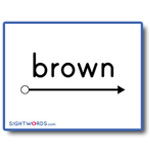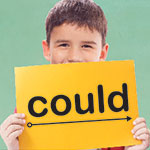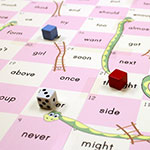Sight Words
Flash Cards
Print your own sight words flash cards. Create a set of Dolch or Fry sight words flash cards, or use your own custom set of words.
1. Overview
Sight words instruction is an excellent supplement to phonics instruction. Phonics is a method for learning to read in general, while sight words instruction increases a child’s familiarity with the high frequency words he will encounter most often.
The best way to learn sight words is through lots and lots of repetition, in the form of flashcard exercises and word-focused games.
2. What Are Sight Words?
Sight words are words that should be memorized to help a child learn to read and write. Learning sight words allows a child to recognize these words at a glance — on sight — without needing to break the words down into their individual letters and is the way strong readers recognize most words. Knowing common, or high frequency, words by sight makes reading easier and faster, because the reader does not need to stop to try and sound out each individual word, letter by letter.
Sight Words are memorized so that a child can recognize commonly used or phonetically irregular words at a glance, without needing to go letter-by-letter.
Other terms used to describe sight words include: service words, instant words (because you should recognize them instantly), snap words (because you should know them in a snap), and high frequency words. You will also hear them referred to as Dolch words or Fry words, the two most commonly used sight words lists.
Sight words are the glue that holds sentences together.
These pages contain resources to teach sight words, including: sight words flash cards, lessons, and games. If you are new to sight words, start with the teaching strategies to get a road map for teaching the material, showing you how to sequence the lessons and activities.
3. Types of Sight Words
Sight words fall into two categories:
- Frequently Used Words — Words that occur commonly in the English language, such as it, can, and will. Memorizing these words makes reading much easier and smoother, because the child already recognizes most of the words and can concentrate their efforts on new words. For example, knowing just the Dolch Sight Words would enable you to read about 50% of a newspaper or 80% of a children’s book.
- Non-Phonetic Words — Words that cannot be decoded phonetically, such as buy, talk, or come. Memorizing these words with unnatural spellings and pronunciations teaches not only these words but also helps the reader recognize similar words, such as guy, walk, or some.
There are several lists of sight words that are in common use, such as Dolch, Fry, Top 150, and Core Curriculum. There is a great deal of overlap among the lists, but the Dolch sight word list is the most popular and widely used.
3.1 Dolch Sight Words
The Dolch Sight Words list is the most commonly used set of sight words. Educator Dr. Edward William Dolch developed the list in the 1930s-40s by studying the most frequently occurring words in children’s books of that era. The list contains 220 “service words” plus 95 high-frequency nouns. The Dolch sight words comprise 80% of the words you would find in a typical children’s book and 50% of the words found in writing for adults. Once a child knows the Dolch words, it makes reading much easier, because the child can then focus his or her attention on the remaining words.
3.2 Fry Sight Words
The Fry Sight Words list is a more modern list of words, and was extended to capture the most common 1,000 words. Dr. Edward Fry developed this expanded list in the 1950s (and updated it in 1980), based on the most common words to appear in reading materials used in Grades 3-9. Learning all 1,000 words in the Fry sight word list would equip a child to read about 90% of the words in a typical book, newspaper, or website.
3.3 Top 150 Written Words
The Top 150 Written Words is the newest of the word lists featured on our site, and is commonly used by people who are learning to read English as a non-native language. This list consists of the 150 words that occur most frequently in printed English, according to the Word Frequency Book. This list is recommended by Sally E. Shaywitz, M.D., Professor of Learning Development at Yale University’s School of Medicine.
3.4 Other Sight Words Lists
There are many newer variations, such as the Common Core sight words, that tweak the Dolch and Fry sight words lists to find the combination of words that is the most beneficial for reading development. Many teachers take existing sight word lists and customize them, adding words from their own classroom lessons.
4. When to Start Teaching Sight Words
Before a child starts learning sight words, it is important that he/she be able to recognize and name all the lower-case letters of the alphabet. When prompted with a letter, the child should be able to name the letter quickly and confidently. Note that, different from learning phonics, the child does not need to know the letters’ sounds.
Before starting sight words, a child needs to be able to recognize and name all the lower-case letters of the alphabet.
If a student’s knowledge of letter names is still shaky, it is important to spend time practicing this skill before jumping into sight words. Having a solid foundation in the ability to instantly recognize and name the alphabet letters will make teaching sight words easier and more meaningful for the child.
Go to our Lessons for proven strategies on how to teach and practice sight words with your child.
5. Scaling & Scaffolding
Every child is unique and will learn sight words at a different rate. A teacher may have a wide range of skill levels in the same classroom. Many of our sight words games can be adjusted to suit different skill levels.
Many of our activity pages feature recommendations for adjusting the game to the needs of your particular child or classroom:
- Confidence Builders suggest ways to simplify a sight words game for a struggling student.
- Extensions offer tips for a child who loves playing a particular game but needs to be challenged more.
- Variations suggest ways to change up the game a little, by tailoring it to a child’s special interests or making it “portable.”
- Small Group Adaptations offer ideas for scaling up from an individual child to a small group (2-5 children), ensuring that every child is engaged and learning.
6. Research
Our sight words teaching techniques are based not only on classroom experience but also on the latest in child literacy research. Here is a bibliography of some of the research supporting our approach to sight words instruction:
- Ceprano, M. A. “A review of selected research on methods of teaching sight words.” The Reading Teacher 35:3 (1981): 314-322.
- Ehri, Linnea C. “Grapheme–Phoneme Knowledge Is Essential for Learning to Read Words in English.” Word Recognition in Beginning Literacy. Mahwah, NJ: L. Erlbaum Associates, 1998.
- Enfield, Mary Lee, and Victoria Greene. Project Read. www.projectread.com. 1969.
- Gillingham, Anna, and Bessie W. Stillman. The Gillingham Manual: Remedial Training for Students with Specific Disability in Reading, Spelling, and Penmanship, 8th edition. Cambridge, MA: Educators Publishing Service, 2014.
- Nist, Lindsay, and Laurice M. Joseph. “Effectiveness and Efficiency of Flashcard Drill Instructional Methods on Urban First-Graders’ Word Recognition, Acquisition, Maintenance, and Generalization.” School Psychology Review 37:3 (Fall 2008): 294-308.
- Shaywitz, Sally E. Overcoming Dyslexia: A New and Complete Science-Based Program for Reading Problems at Any Level. New York: Alfred A. Knopf, 2003.
- Stoner, J.C. “Teaching at-risk students to read using specialized techniques in the regular classroom.” Reading and Writing: An Interdisciplinary Journal 3 (1991).
- Wilson, Barbara A. “The Wilson Reading Method.” Learning Disabilities Journal 8:1 (February 1998): 12-13.
- Wilson, Barbara A. Wilson Reading System. Millbury, MA: Wilson Language Training, 1988.
Leave a Reply





25 Responses to “Sight Words”
Yeonsu Lee
Thank you for great information!
Cee Cee
Thank you for seeking answers to reading problems some people have.
Kelly Cain
Thank you for sending the link to my mom for this website, i can’t wait to explore it more and introduce it to my kids!!
Salex Dihan
Do you break up the sight words to make it easy?
ADMIN – Hi Salex,
Yes, you will only work on a couple of new Sight Words at a time. The youngest children can only handle 2-3 new words at a time. Third graders can handle introducing 5 to 10 new words at a time.
Julia
Isn’t teaching sight words the same thing as teaching with the thoroughly discredited whole-word reading method?
ADMIN – Hi Julia,
We get strong readers teaching Sight Words in conjunction with Phonics.
If you teach only phonics, where a child is sounding out words as their only approach, you run into two problems. First, some words are phonetically irregular (such as ‘little’), and can’t be sounded out. Second, sounding out even common words (such as ‘the’), makes reading slow.
If you are teaching only Sight Words, there are also problems. First, if you come across an unfamiliar word, you won’t have many strategies to figure out the word. Second, when you start writing, spelling is going to be harder for you.
Gerry Martin
Thank you SO much for all of this information about sight words and related reading concepts. I will relay this info to friends with children with special needs.
Jose Hernandez, Sr
After retiring from the USAF as an Education and Training officer and began a second career as a teacher. I was amazed at the number of children in middle and high school grades who lacked reading skills. My retirement from teaching coincided with daughter’s assignment to a near by military base and my grandson’s preK eligibility. In our rural area the trip to school was a major concern therefore we decided that I would home-school my four year old grandson instead. From various sources I compiled and printed 393 sight words on 3 by 5 index cards for first to third grade students. Now at age 5 and a half and in kindergarten he can read third grade sight words and he is learning phonics at school. Our sessions are very short (20 minutes) and simple. He has 15 seconds to read a randomly selected index card. A correctly read word earns a check mark and if he can use it in a sentence he earns a plus sign too. I have four stacks of cards as follows: 1) Main stack, 2) one checkmark, 3) two checkmarks, 3)Mastered (Three checkmarks). It works. At school his teacher has him read to the other students to help motivate them.
Anita Holaday
In looking over your material here on the internet I see no classroom checklist for all students in the class so the teacher can at a glance tell what words most of her students do not know. This is very important when using a direct instruction mode of teaching reading.
ADMIN – Hi Anita,
Thanks for the suggestion! The feedback we receive from our users helps us decide what features to add to the site.
Myeisha
Thank you for the great information on sight words. I am homeschooling my 4 year old son with ADHD and autism for preschool. I will be teaching him sight words over the summer to get him prepared for kindergarten.
Jessica
Thank You! Your site is wonderful. Everything I need is right here, easy to find. I can’t wait to start using your tools to teach my DD.
ghada
Thanks … It is the best website talk about that topic … It is really helpful 🙂
Tonya Mercer
Last year there was a pre-test on here to see what sight words they were missing. Where can I find that again. This site is wonderful.
ADMIN – Hi Tonya,
Thanks! Our site has never had a pre-test for sight words, but I recommend that you quiz your child with flash cards for the words you think they should know. You can use our card generator to create flash cards from a custom word list. Set aside any words the child stumbles on, and give those words further review using our five teaching techniques.
Terri Hecht
My 5yo grandson has a lot of signs of dyslexia. He is starting kindergarten and does not recognize all his letters or numbers. We have worked a lot with him. This looks like it could help. Are there pictures for words like my, an, etc?
ADMIN – Hi Teri,
Our Phonemic Awareness curriculum is a great place to start with your grandson. I recommend that you start with the Compound Words module, and then work through the Syllables activities until he is firm in his understanding of the concepts. Here are a few other suggestions for you to pursue:
1. If your grandson’s school has a speech/language pathologist (SLP), set up a meeting. If the SLP knows the Fast ForWord program, that may help your grandson.
2. Consider using Teach your Child to Read in 100 Easy Lessons at home daily.
3. Read Overcoming Dyslexia by Sally Shaywitz. It will give you some good information and strategies.
4. Buy a set of sandpaper alphabet letters. Have him use his first two fingers of his dominant hand to trace and repeat the names of the letters. Start with letters that look the same in both upper and lower case form (Cc, Ss, etc.). Then have him close his eyes (or use a blindfold) and move his two fingers to trace over the letter and see if he can name it. If he can’t, give him a choice of two, then three, then four to choose from. When he is firm with naming the letters when tracing them, use the same letters without a blindfold, mix them with other letters, point to one he’s traced, and have him name it. Once he’s learned the similar-looking upper-case and lower-case letters, add the dissimilar ones (Hh, Gg, etc.).
5. There are no visuals for words like my or an except in sign language. They are high frequency words that can be learned using our sight words teaching techniques after he has learned the names of all the lower-case alphabet letters.
6. Send his school a written communication requesting an evaluation to determine if a learning ability is evident. Date it and keep a copy! The request probably won’t be acted upon for a while, but it will put them on notice that you are concerned and why. This will strengthen your case if he continues to have problems that aren’t addressed.
7. If there is a tutor trained in Orton-Gillingham methodology in your area, look into hiring that person to help your grandson.
Melinda Buie
Can you recommend some research articles that look specifically at air writing and its benefits?
Thank you.
ADMIN – Hi Melinda,
Try this: http://www.resourceroom.net/readspell/2002_automaticity.html
Bezl Lynn
First time to bump into this incredible resourceful website. I am simply loving all the helpful and guided links and instructions.
Josephine Francis
Would like to have a set of simple reading sentences for a 5 year old child
Chidalu
Thanks so much. I was able to train my teachers on using and teaching sight words with your materials and guide. I’m grateful. You guys are doing a great job here!!!!
Shelly
Thank you for this information, I combined these lists to fit the needs of my ESL students here in Asia. We learn 5 words a week in my kindergarten class and I am so proud of them all and their current reading skills. They all passed their reading test for entering 1st grade.
Fadi
Thank you…… It is really helpful.
Bette Mroz
I am a retired first grade teacher, reading specialist, principal and always educator. I now write a column for parents to know HOW to help their children learn called SUPPORTING SUPER STUDENTS (www.supportingsuperstudents.org). Since I am writing once again about helping children learn to read, I recommended your website as a resource for parents determined to help their children learn to read–whether educated publicly, privately or at home. It is one of the best for beginning readers. Thank you and I hope I have your permission for this recommendation.
Amy
Do you have any tips for teaching the alphabet? I homeschool and am trying to figure out where to start with my 4 and 5 year olds. If we start with the phoneme curriculum, should we be teaching letter recognition at the same time? Or is that part of the phoneme curriculum?
m.aljafla
Thank you. It is really helpful to have the sight words games, flash cards, and lessons!
madison bennett
Really good!
Carl Brodanx
really good
Nalin Karunarathne
Excellent resources, specially as we are learning English as secondary language. really appreciate your work.